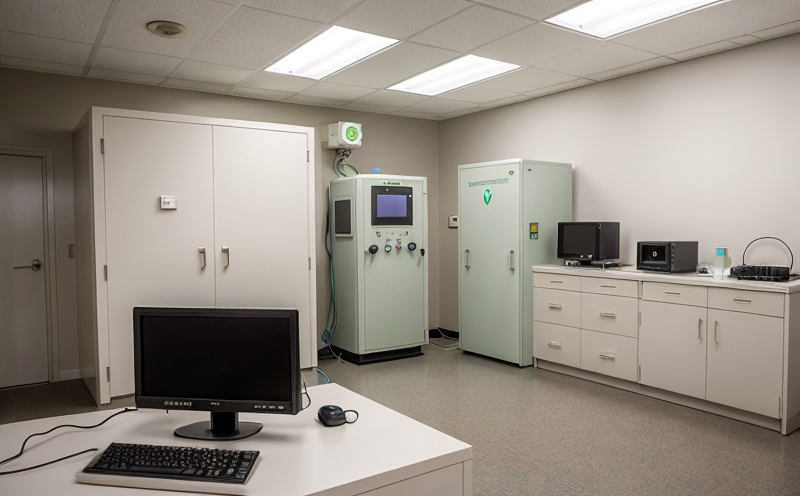ISO 21989 Calibration of Eye Dose Equivalent Hp(3)
The calibration of eye dose equivalent according to ISO 21989 is a critical process in radiation and nuclear testing, ensuring compliance with international safety standards. The eye represents one of the most sensitive organs for ionizing radiation exposure due to its limited repair mechanisms following DNA damage.
The Hp(3) quantity refers specifically to the effective dose equivalent at the anterior chamber of the eye, which is particularly relevant in occupational and medical scenarios where workers or patients are exposed to potentially harmful levels of ionizing radiation. This calibration process involves several steps that ensure accurate measurement and reporting of radiation exposure.
Firstly, it requires a detailed understanding of the dosimetry principles underpinning ISO 21989, which defines how to measure and quantify radiation exposure accurately. Secondly, specialized equipment such as tissue-equivalent phantoms calibrated against reference standards is used for precise measurement. These phantoms simulate human tissues and are essential for validating the accuracy of dose measurements.
The process also involves rigorous testing protocols that adhere strictly to ISO 21989 guidelines. This includes careful preparation of specimens, often involving precise modeling of eye structures in tissue-equivalent materials. The calibration procedure itself is conducted using high-precision detectors capable of distinguishing between different types and energies of radiation.
The importance of this service cannot be overstated, especially given the stringent regulatory requirements governing exposure limits for occupational and medical settings. By ensuring accurate Hp(3) dose measurements, this service plays a pivotal role in safeguarding worker health and preventing unnecessary radiation-induced injuries or diseases.
Moreover, ISO 21989 compliance is crucial for maintaining accreditation with bodies such as the International Atomic Energy Agency (IAEA), the U.S. Nuclear Regulatory Commission (NRC), and other national regulatory authorities. This ensures that facilities adhering to these standards can operate efficiently while meeting all necessary safety requirements.
Given the complexity of this calibration procedure, it is important for organizations involved in radiation testing to partner with reputable laboratories capable of providing accurate and reliable results. Our laboratory offers extensive experience in performing ISO 21989 calibrations, leveraging cutting-edge technology and expertise to deliver precise measurements.
The accuracy of Hp(3) dose equivalent measurements is paramount for ensuring compliance with international standards and protecting both workers and patients from excessive radiation exposure. By adhering strictly to ISO 21989 protocols, we can provide the necessary confidence in our clients' radiation safety measures.
Benefits
- Ensures accurate measurement of eye dose equivalent according to internationally recognized standards.
- Promotes compliance with regulatory requirements for occupational and medical settings.
- Supports the safety protocols of organizations involved in radiation testing.
- Facilitates efficient operation by maintaining accreditation with leading regulatory bodies.
- Aids in preventing unnecessary exposure to ionizing radiation, thereby safeguarding health.
- Enhances the reliability and credibility of test results, which is essential for maintaining a safe working environment.
Quality and Reliability Assurance
- We employ highly trained technicians with expertise in radiation dosimetry.
- The laboratory adheres strictly to ISO 21989 standards throughout the calibration process.
- Use of state-of-the-art equipment calibrated against reference standards ensures precision.
- Ongoing training and certification for staff members ensure adherence to best practices.
- Detailed documentation and reporting facilitate traceability and auditability.
Customer Impact and Satisfaction
The accuracy of Hp(3) dose equivalent measurements directly impacts the safety and health of workers in occupational settings. By ensuring compliance with international standards, our service helps organizations avoid potential legal issues and financial penalties associated with non-compliance.
Clients appreciate the reliability and precision of our results, which are essential for maintaining accreditation and operational efficiency. The confidence provided by accurate Hp(3) dose measurements allows facilities to continue operations without disruptions caused by regulatory concerns or safety lapses.
Our commitment to quality and customer satisfaction is reflected in the positive feedback we receive from clients who rely on our expertise for radiation testing. By partnering with us, organizations can rest assured that they are meeting stringent safety standards while also enhancing their reputation as responsible operators within the industry.





